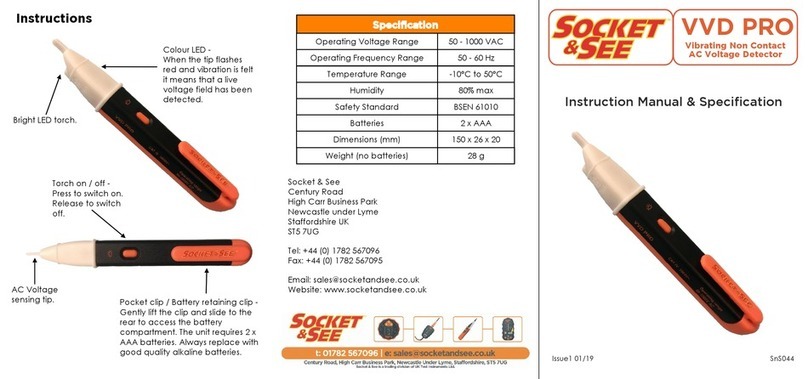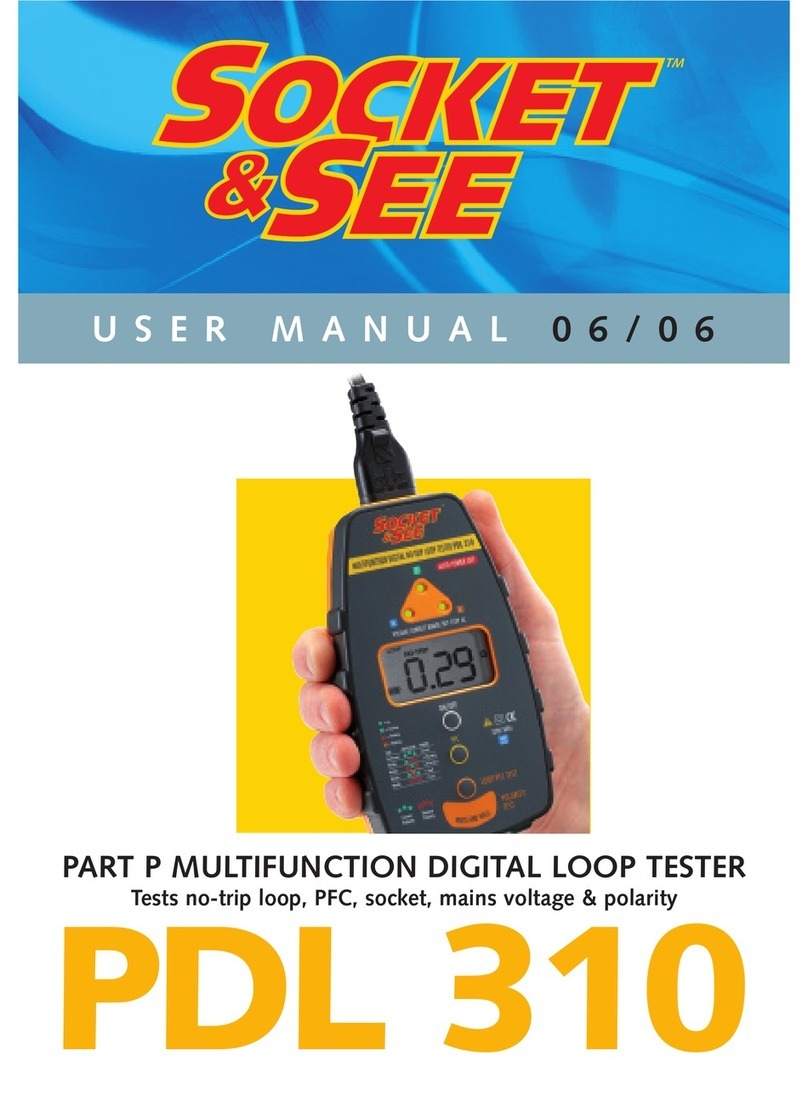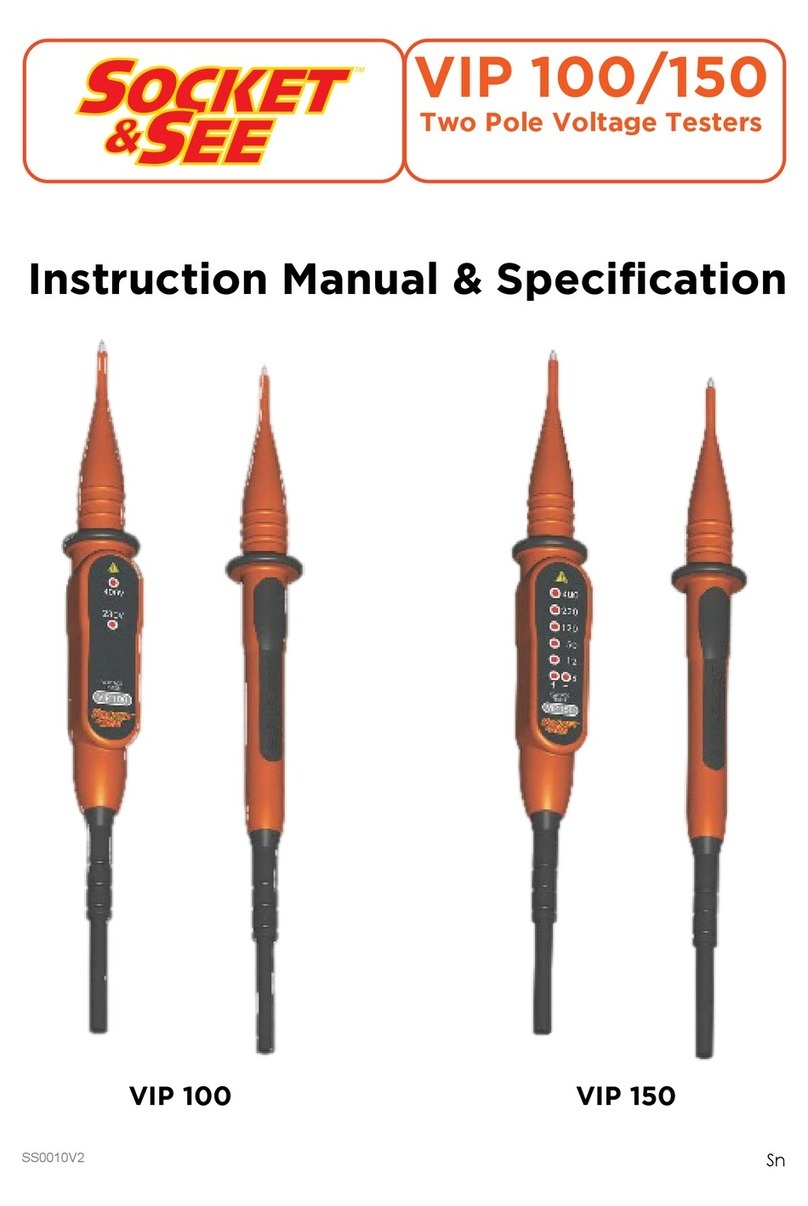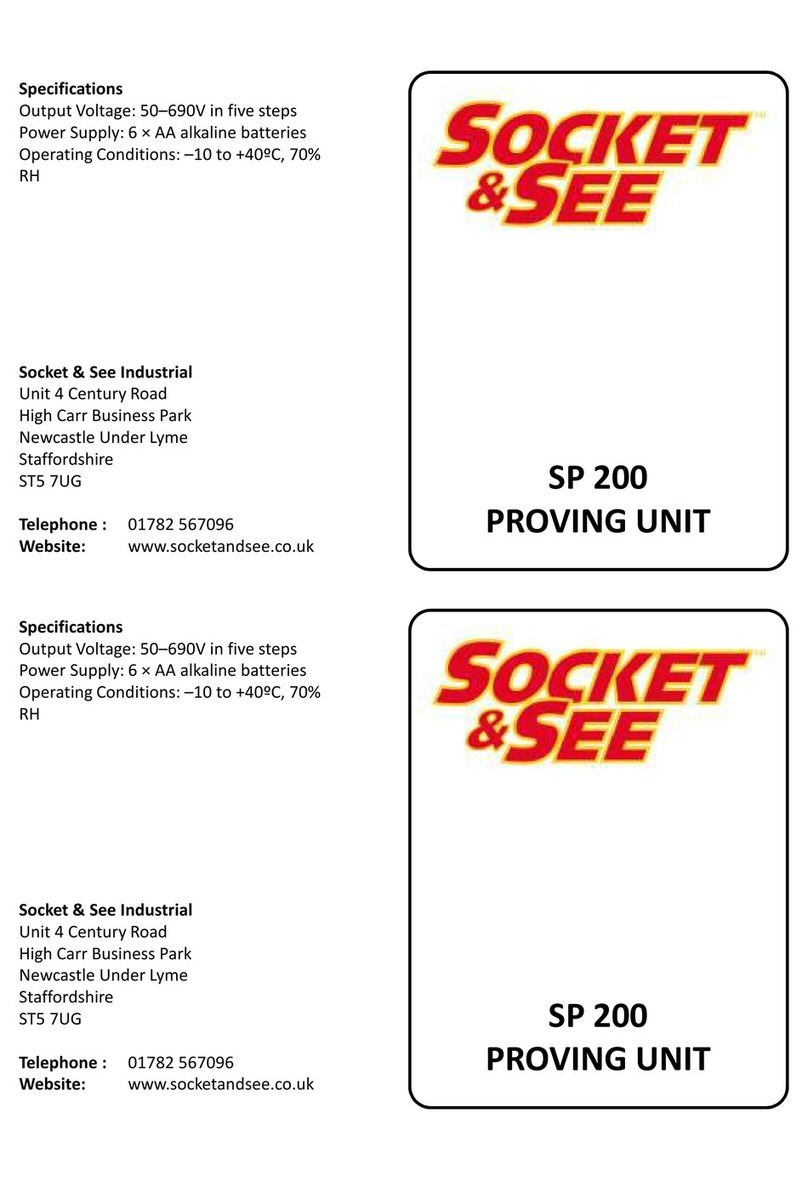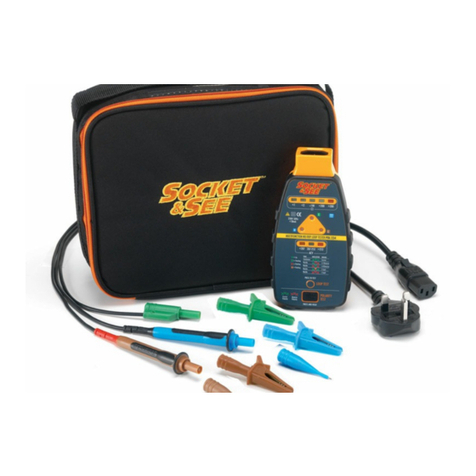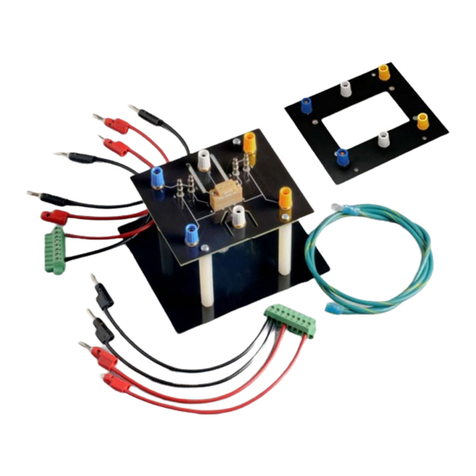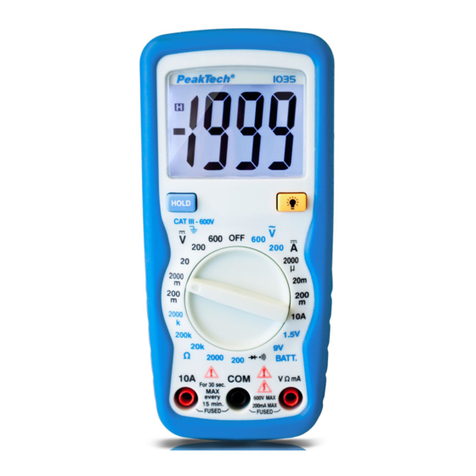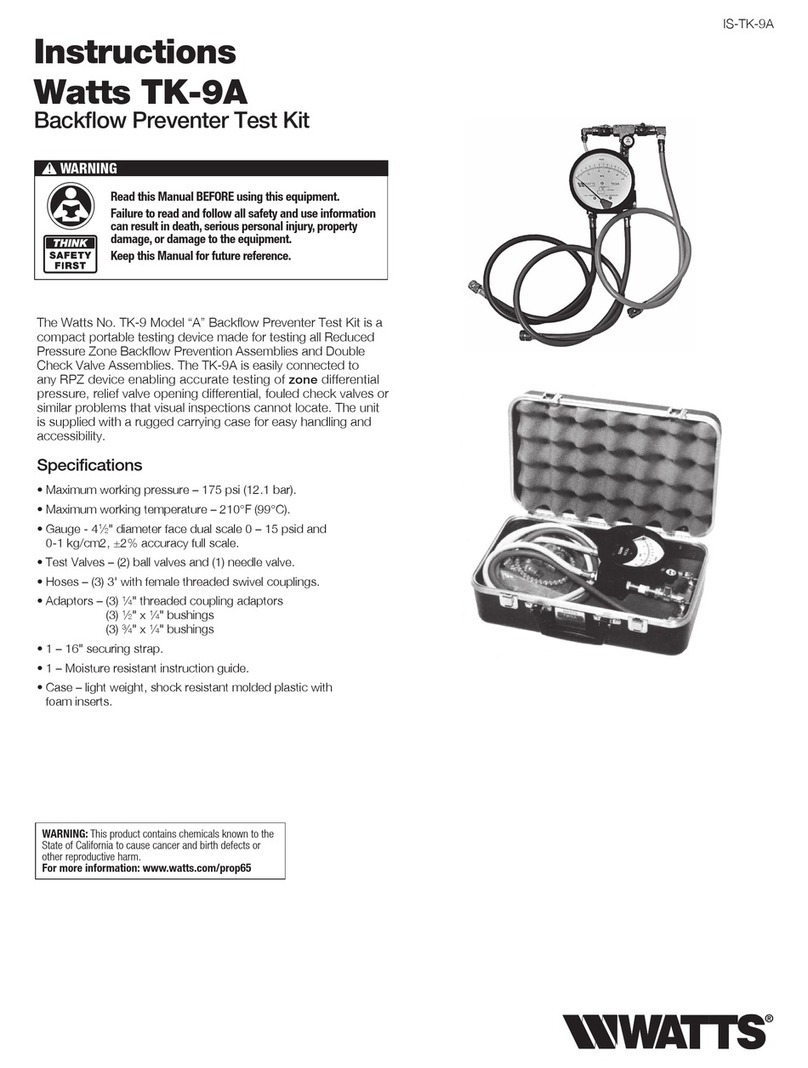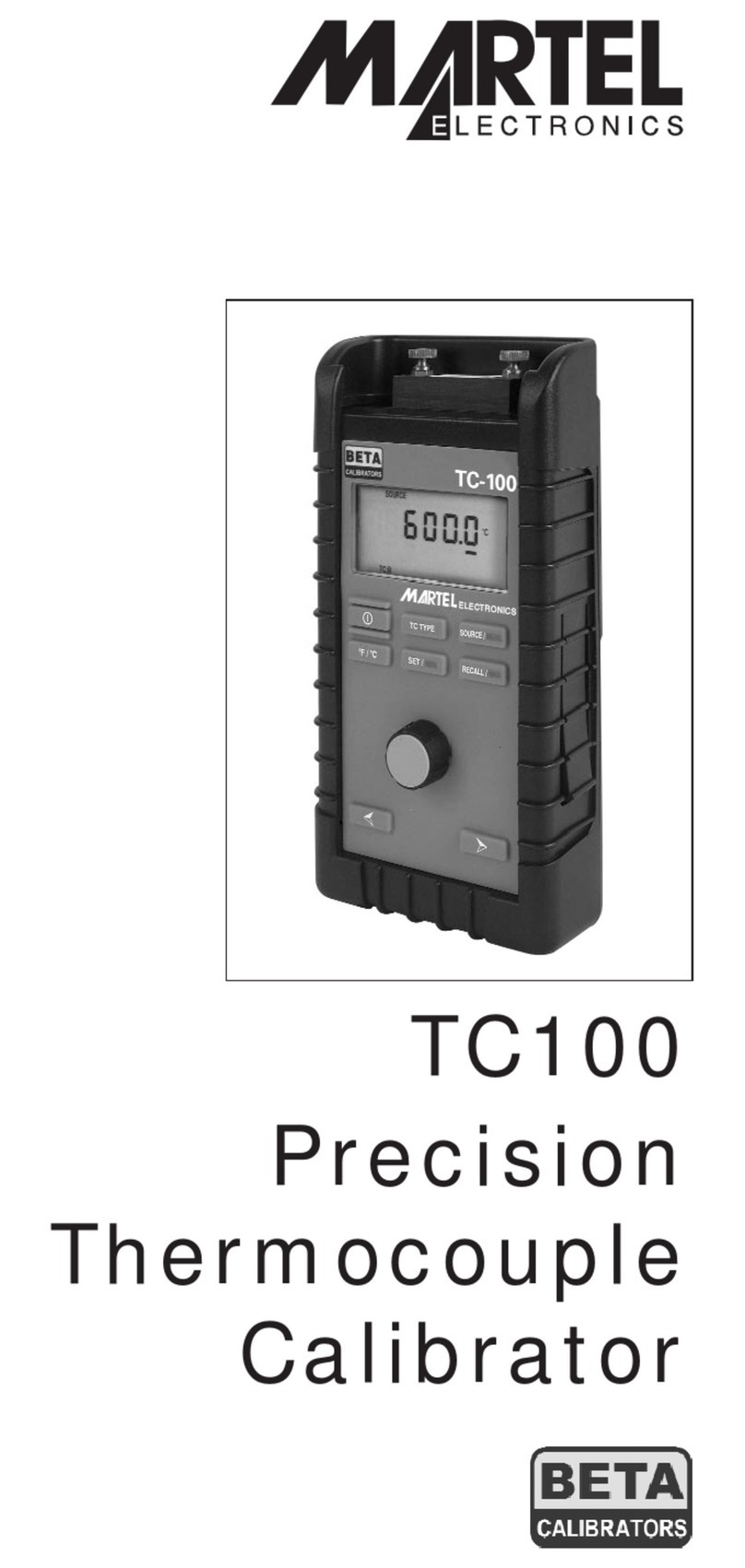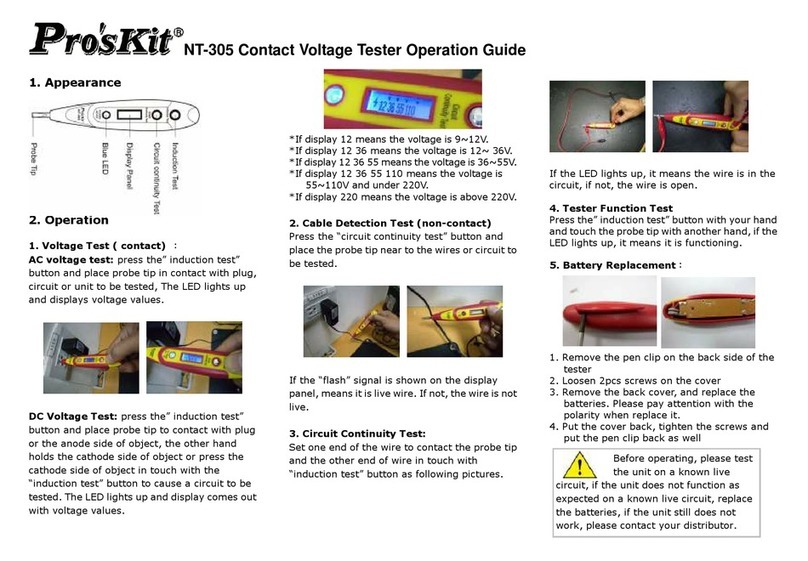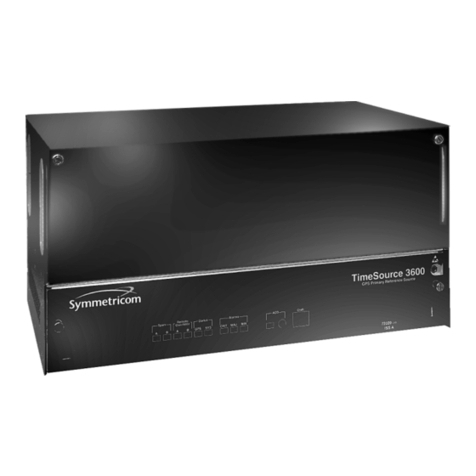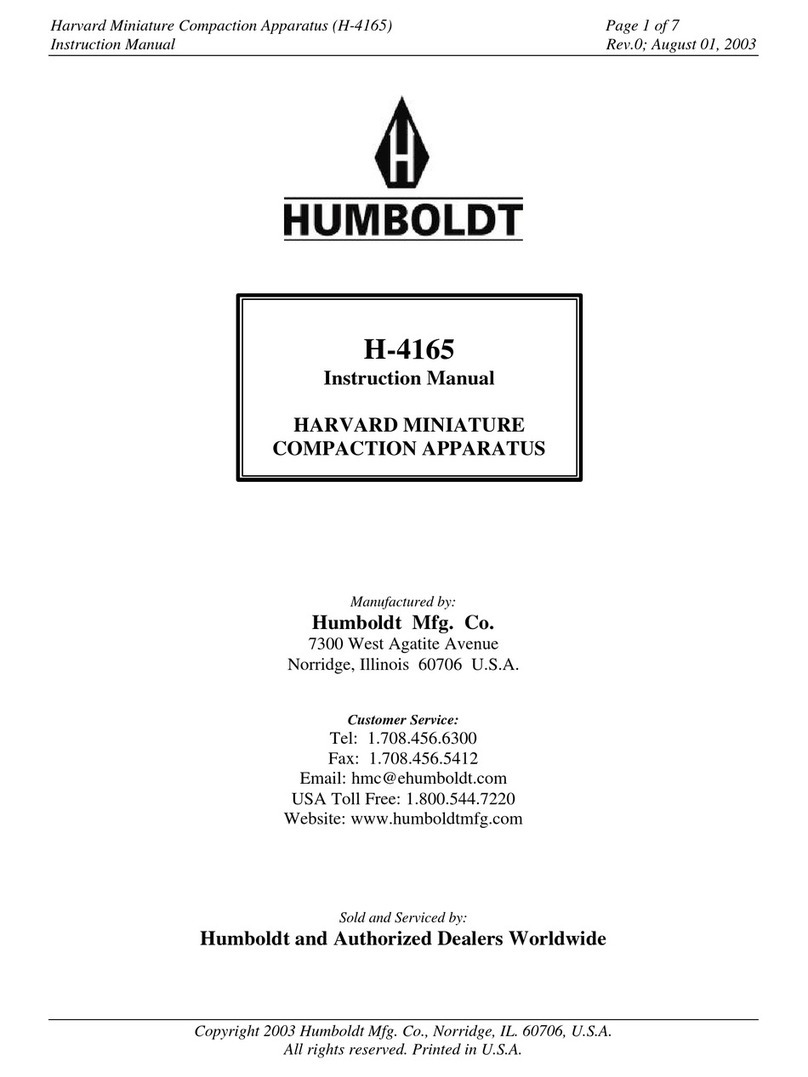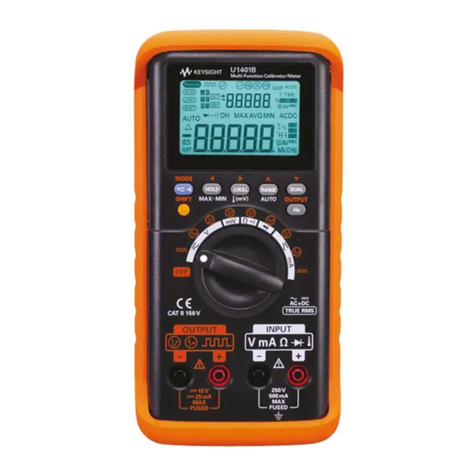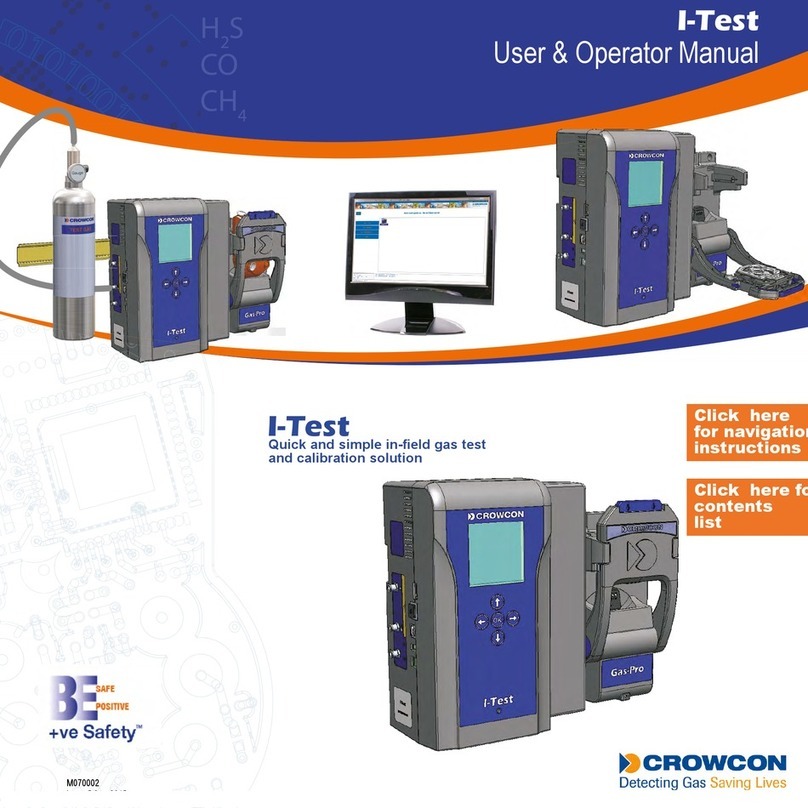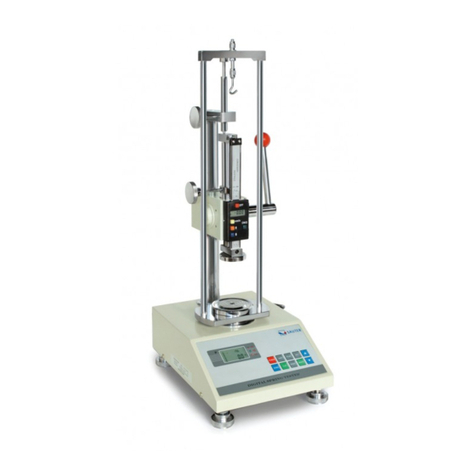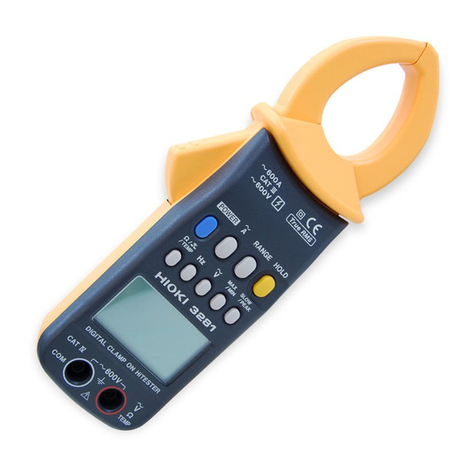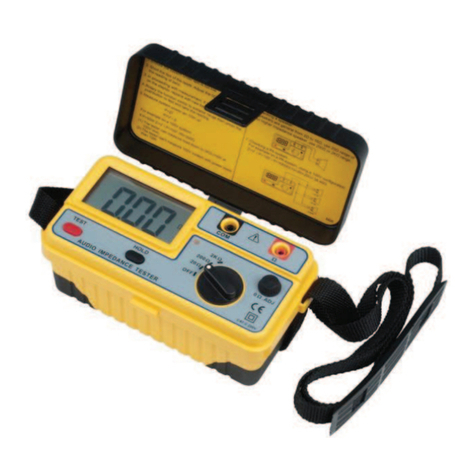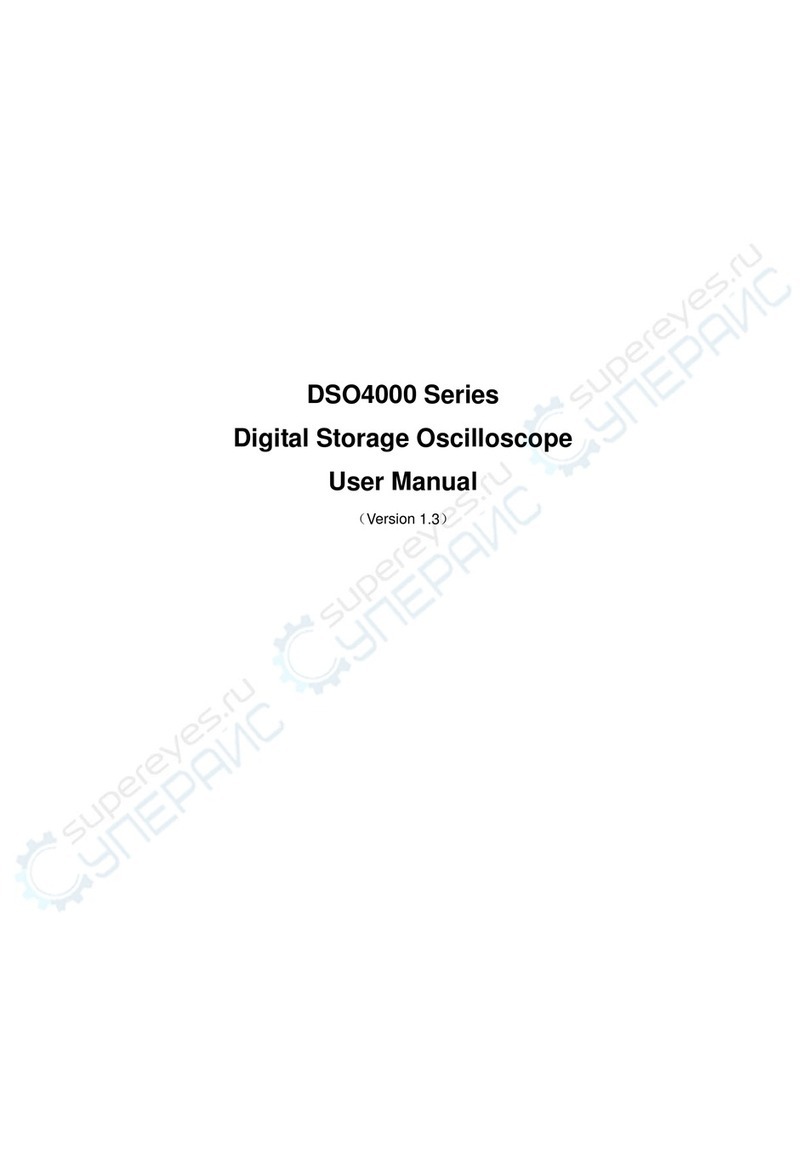Socket & See CB400 User manual

Instruction Manual & Specification
CB400
Professional Non-Trip
Checkbox
SS001V2 Sn

2
SS001V2
1. Safety
1.1 Equipment Markings
1.2 Operational Safety
The Socket and See CB400 is designed to be used by skilled persons in
accordance with safe methods of work. If the CB400 is used in a manner not
specified by Socket and See, the protection provided by it may be impaired.
Inspect the CB400 before using. If any damage is visible such as cracks in the
casing or damage to leads the unit should not be used.
Caution - refer to this instruction manual
Construction is double insulated
Product should be recycled as electronic waste
Conforms to EU standards
Measurement Category III is applicable to test and measuring circuits
connected after the source of the building’s low-voltage MAINS
installation. This part of the installation is expected to have a
minimum of two levels of over-current protective devices between
the transformer and connecting points of the measuring circuit.
Examples of CAT III are measurements on devices installed after the
main fuse or circuit breaker fixed within the building installation. Such
as junction boxes, switches and socket outlets.
CAT

3
SS001V2
2. Description
The CB400 provides a quick and simple method of checking the accuracy of
17th edition electrical installation test instruments.
It does not replace the requirement for formal calibration but depending upon
the instrument manufacturer, it may allow extended periods between formal
calibration. It provides a ready check on instrument accuracy helping to
minimise incorrect certification and costly revisits to confirm installation
compliance.
It can be used for recording ongoing accuracy checks to monitor the
performance of instruments over a period of time or as an on site portable
device to confirm the correct operation of an instrument when faced with an
unusual reading.
The CB400 provides accuracy checks at up to 9 test points for test instruments
used to measure.
●Continuity
●Insulation resistance
●Earth fault loop impedance
●Operation of residual current devices
2.1 Contents
●IP 54 carry case
●A Socket & See CB400 checkbox
●Mains power lead 13A to IEC connector
●1 pair 4mm safety plug test leads
●Calibration certificate
3. Usage
The CB400 incorporates a unique “No Trip” circuit to enable the safe check of
RCD testers and high current loop testers without the risk of tripping the supply
RCD.
For checking insulation or continuity functions you can use your own
instrument’s test leads to connect your instrument to the corresponding 4mm
input terminals on the face of the CB400 if they terminate in a 4mm plug.
Alternatively you can use the supplied pair of red and black leads.
For checking loop or RCD functions plug your tester into the 13A style test socket
labelled “LOOP OR RCD TESTER”.

4
SS001V2
When you connect the CB400 to the mains supply it will select the insulation
0.25MΩ test position by default. Use the cursor keys to select the appropriate
function and value for the instrument to be tested.
3.1 Recording reference values for ongoing accuracy records
When using the CB400 to check an instrument for the first time it should be in
current calibration.
When the first set of tests for any instrument are undertaken.
●A separate test record sheet should be kept for each instrument.
●Each test should be repeated 3 times to establish the initial test value for
each particular instrument.
●The value obtained over the three tests should be similar and within the
instrument manufacturer’s tolerances.
●The average value over the three tests should be recorded on the
instrument test record as the Reference Value.
●It is the Reference Value which will be used for future accuracy checks on
the instrument.
3.2 Check box calibration values
Important: As there are always slight differences between the values of
components used, the actual check values of each check box are likely to vary
slightly from the nominal values on the CB400 face label.
Each CB400 is calibrated and the actual values of your individual CB400 are
shown on the calibration summary label inside the lid. It is this calibrated value
rather than the nominal value shown on the panel label that should be used
when comparing measured readings to an instrument manufacturer’s
specification.
3.3 Checking Continuity Performance
What is meant by ‘nulling’ test leads and why is it important
Continuity measurements are often made on circuits with very low resistances
with values of less than 1Ω. Most measuring instruments measure the total
resistance value between the instrument terminals including the resistance of all
connected test leads, whereas the required result is that for the circuit without
the test leads. It is therefore necessary to measure the resistance of the test
leads and deduct this value from the overall result; this is known as lead nulling.

5
SS001V2
Many continuity testers have a ‘Lead Null’ function that after an initial
measurement of lead resistance, will automatically deduct this value from
subsequent readings until reset. When using continuity testers without a ‘lead
null’ function it is necessary to measure the value of lead resistance and
manually deduct it from all measurements.
It is essential to either null the leads or deduct the lead resistance from the
measured value so that the check on the accuracy of the instruments is not
affected by the test leads used. This is because the resistance of the leads may
vary with use or the leads may be replaced during the lifetime of the instrument.
The CB400 includes a ‘lead null’ position for the continuity test range. This can
be used either to null the leads if the test instrument being checked includes a
lead null function or to measure the lead resistance for instruments without this
function.
Confirmation of correct test current
EN 1557 requires that continuity testers should be capable of at least 200mA test
current. The CB400 conducts this important check at the 2.0Ω check point. If the
output current is correct the ‘output current correct’ LED at the far end of the
continuity scale will illuminate when testing at the 2.0Ω check point.
Instruments with a Lead Null Function
Nulling
●The leads should be connected between the instrument and the 4mm
terminals on the CB400.
●Use the cursor to select the ‘NULL’ function on the continuity range. This
provides a direct link between the two leads and allows them to be nulled.
●Null the leads in accordance with the instrument manufacturer’s
instructions..
Once the leads have been nulled and providing the instrument is not switched
off, there will be no need to subtract the test lead values from the measured
value of the test leads from any other measurements.
If the instrument is switched off the null process will need to be repeated.
3.4 Continuity Check
●The instrument to be checked should be set to the most appropriate scale
and the continuity test carried out at each of the check points on the
CB400.
●The value obtained should be recorded on the test instrument record sheet.

6
SS001V2
●The recorded values are compared with the reference values to assess the
performance of the instrument over time, or compared to the
manufacturer's specification to confirm that the instrument is still within
calibration.
●If the measured values are found to be within the manufacturer’s
specification and tolerance then the instrument is suitable for continued
use.
●If any of the measured values are outside the manufacturer’s tolerance
then the instrument will need to be returned for calibration.
Instruments Without Lead Null Function
Measuring Resistance
Where there is no lead null option on the instrument to be checked the null
position can be used to establish the resistance of the test leads.
●With the NULL position selected the instrument should be set to the lowest
resistance scale and operated in the normal way.
●The valve measured by the instrument will be the resistance of the test
leads. Make a note of this value as it must be subtracted from the check
values obtained when checking at the other five check points.
Continuity Check
●The instrument to be checked should be set to the most appropriate scale
and the continuity test carried out at each of the check points on the
CB400.
●Subtract the resistance value of the leads that you previously measured
from the instrument reading. The value obtained should be recorded on the
test instrument record sheet.
●The same procedure should be followed using the other five check points
on the CB400.
●The recorded values are are compared with the reference values to assess
the performance of the instrument over time.
●If the measured values are found to be within the manufacturer’s tolerance
then the instrument is suitable for continued use.
●If any of the measured values are outside the manufacturer’s tolerance
then the instrument will need to be returned for calibration.

7
SS001V2
3.5 Tolerance Examples
If the instrument tolerance is 2% then the measured value should be within 2% of
the calibration check value shown checkbox calibration certificate. So if the
reference value is 0.5Ω the measured value should be between 0.51Ω and
0.49Ω.
If the instrument is 2% 20mΩ then the measured value should be within 2% and
20mΩ of the reference value. So if the reference value is 0.5Ω the measured
value should be between 0.53Ω and 0.47Ω.
3.6 Insulation Resistance Checks
There is no requirement to null the test leads for insulation resistance test checks.
The CB400 can be used to check insulation resistance testers across the voltage
range. This enables the test instrument to be checked on the 250V, 500V and
1000V settings.
●Select the appropriate resistance scale and test voltage on the instrument
being checked.
●The insulation resistance tester is then operated in the normal way.
●The measured value obtained is recorded on the test instrument record
sheet.
●The same procedure is followed for each of the check points on the CB400
insulation range.
●These same tests may then be repeated for each test voltage if required.
The measured values obtained are compared with the Reference Values to
assess the performance of the instrument over time. If the measured values are
found to be within the manufacturer’s tolerance then the instrument is suitable
for use. If any of the measured values are outside the manufacturer’s tolerance
then the instrument will need to be returned for calibration. Refer to section 3.5
For examples of how to apply tolerances.
Confirmation of Correct Voltage Output.
The CB400 also includes an important function that checks the output voltage
at one point on each range. The voltage check point is at 0.25MΩ for the 250V
range, 0.5MΩ for the 500V range and 1MΩ for the 1000V range. When testing at
these points the appropriate LED in the section at the right hand side of the
insulation range will light if the test voltage is correct.

SS001V2
8
3.7 Earth Fault Loop Impedance Checks
The CB400 provides a facility to check the accuracy of earth fault loop
impedance testers. The CB400 provides tests of:
●CB400 ‘local’ earth fault loop impedance.
●CB400 ‘local’ earth fault loop impedance with an additional 1Ω
included.
●CB400 ‘local’ earth fault loop impedance with an additional 100Ω
included.
The ‘local loop’ is the value measured at the CB400 test socket without any
additional resistance switched into the circuit. As the CB400 internal circuit
provides some additional resistance the ‘local loop’ value from the CB400
test socket will be slightly higher than the loop value measured directly from
the actual supply socket. As the CB400 will be used to check the accuracy of
the instrument it is strongly advised that:
●Both of the plugs (13A and IEC) used to connect the CB400 to the mains
supply and both ends of the test lead used to connect the instrument to
the CB400 socket are each inserted and removed several times before
undertaking the accuracy check. This process will help to reduce any
additional resistance which may be caused by tarnishing of the pins or
socket tubes.
Note: Where the instrument being checked does not have an inbuilt on/off
switch the instrument must be unplugged from the CB400 when changing the
earth fault loop settings with the cursor key.
Site Check
The CB400 provides a fast check option for the earth fault loop impedance
tester. This enables the instrument to be checked on site to confirm the
accuracy of the instrument measurement. This site consists of a measurement
of the CB400 local loop and then with 1Ω resistance added and finally with
100Ω resistance added. This will identify whether the instrument is accurately
measuring the 1Ω and 100Ω increase. This check may be carried out at any
suitable socket outlet.
●The CB400 should be plugged into a suitable power socket and set to the
‘local’ setting.
●The earth fault loop impedance tester is then plugged into the CB400 test
socket and the tester operated. The measured value is recorded.

●The test instrument is then switched off or on to disconnected from the
CB400 for a period of 5 seconds. If the tester has an on/off switch it should
be used in preference to disconnection.
●Use the cursor to select +1Ω position.
●The instrument is then switched on or plugged back into the CB400. The
earth fault loop impedance is then carried out. The measured value is
recorded on the instrument record sheet. Comparing the ‘local loop’ value
and the +1Ω value should show the increase of 1Ω (or more accurately the
calibrated value for the 1Ω setting) within the manufacturer’s tolerance.
●The test instrument is then switched off or unplugged from the CB400 for a
period of 5 seconds
●Use the cursor to select +100Ω position.
●The instrument is then switched on or plugged back into the CB400.
●The earth fault loop impedance test is then carried out in the usual way. The
measured value is recorded on the instrument record sheet.
Comparing the ‘local loop’ value and the +100Ω value should show the
increase of 100Ω (or more accurately the calibrated value for the 100Ω setting),
within the manufacturer’s tolerance. Refer to section 3.5 for examples of how to
apply tolerances.
Ongoing Accuracy Record
To give a more exact indication of the instrument accuracy it is strongly
recommended that the same dedicated power outlet is used each time for the
checks. This will allow the instrument to be compared with the:
●Actual loop value
●CB400 ‘local loop’ value at the socket
●CB400 ‘local loop +1Ω’ value
And
●CB400 ‘local loop +100Ω value
This process will give a reference against three Reference Values and provide
more precise indication of the instrument accuracy. The earth fault loop
impedance tester is used to:
9
SS001V2

10
SS001V2
1. Test and record the actual loop impedance from the dedicated socket
outlet.
2. Test and record the CB400 ‘local loop’ value.
3. Test and record the ‘local loop +1Ω’ value.
4. Test and record the ‘local loop +100Ω’ value.
Each of the above tests is repeated three times and the average value
recorded as the Reference Value for each test. The Reference values
obtained for tests 1,2,3 and 4 above (socket loop, local loop local loop +1Ω
and local loop +100Ω ) then provide four reference points with which to
compare the instrument accuracy.
3.8 Residual Current Device Checks
The CB400 provides a facility to check the accuracy of residual current device
test instruments relative to the testing of 30mA and 100mA RCD’s, the most
common types used for additional protection.
●½ x I∆n test at 15mA
●1 x I∆n test at 30mA
●5 x I∆n test at 150mA
Can be carried out at the CB400 test socket. The CB400 checks both the
accuracy of the displayed disconnection time and the accuracy of the
tester’s output current.
Note: The CB400 function for the 1 x I∆n and the 5 x I∆n test has a set operation
time of 38mS. So the instrument being checked should display a value. Subject
to the instrument manufacturer’s tolerance of 37 - 39mS.
Site Check
The connection to the CB400 is made using the instrument test lead which is
fitted with a BS1363 (13A) plug plug into the test socket. The selection switch is
set to the RCD position and the test instrument plugged into the CB400.
1 x I∆n (30mA)
●The instrument is set to the 30mA and the 1 x I∆n (30mA) setting at 0º.
●The test is then carried out on the instrument. The reading obtained should
be between 37mS and 39mS subject to the manufacturer’s tolerances.

11
SS001V2
The illumination of the test current LED on the CB400 indicates that the test has
been carried out and the instrument output current is acceptable. If the output
current from the tester is outside the acceptable range then the tester may still
operate the RCD trip but the LED will not light. If this happens the test result
obtained ( the displayed disconnection time) is not valid as the tester has failed
to supply the indicated test current. he CB400 automatically resets ready to test
after a period of around 4 seconds when the LED goes out.
●The instrument is then set to 30mA and 1 x I∆n (30mA) setting at 180º and
the above test repeated.
5 x I∆n (150mA)
●The instrument under test is then set to the 5 x I∆n 150mA setting at 0º.
●The test is then carried out at the instrument.
The reading obtained on the test instrument should be between 37mS and
39mS subject to the manufacturer’s tolerances. The illumination of the 150mA
LED on the CB400 indicates that the test has been carried out and the
instrument output current is acceptable. If the output current from the tester is
outside the acceptable range then the tester may still operate the RCD trip but
the 150mA LED will not light. If this happens the test results obtained (the
displayed disconnection time) is not valid as the tester has failed to supply the
indicated test current. The CB400 automatically resets ready to test after a
period of around 4 seconds when the LED goes out.
●The instrument is then set to the 5 x I∆n 150mA setting at 180º and the
above test repeated.
½I∆n (15mA)
●The instrument under test is then set to the ½ x I∆n 15mA setting at 0º.
●The test is then carried out at the instrument.
●The illumination of the 15mA LED on the CB400 indicates that the test has
been carried out and the instrument output current is acceptable.
●The CB400 automatically resets ready to test after a period of around 4
seconds when the LED goes out.
●The reading obtained on the test instrument should indicate that the trip
did not occur in the 2 second time period. (The reading shown will depend
upon the test instrument being used as this varies according to the
manufacturer.) If the output current from the tester is outside the
acceptable range then the tester may still indicate that the trip did not

12
SS001V2
4. Maintenance and Service
If required, clean with a damp cloth and mild detergent. Do not use abrasives
or solvents.
There are no user-serviceable parts. Contact Socket and See for service and
technical assistance:
Socket and See
Century Road
High Carr Business Park
Newcastle
Staffordshire, UK
ST5 7UG
Tel: 01782 567096
Fax: 01782 567095
Email: [email protected]
Website: www.socketandsee.co.uk
occur in the 2 second time period but the 15mA LED will not light. If this happens
the test result obtained is not valid as the tester has failed to supply the
indicated test current. If satisfactory press the phase selection switch to change
the test phase angle to 180º and repeat the above tests.
Ongoing Accuracy Record
The procedure given above for the site check may also be used to provide a
record of ongoing accuracy for the RCD test instrument. This is possible because
the test of the RCD instrument is carried out within the CB400 unit and is
independent of any external influence. The test should be carried out at regular
intervals and the results recorded on the ongoing accuracy record sheet for the
instrument. Refer to section 3.5 for how to apply tolerances.

SS001V2
Specification
Function Check Values Accuracy Rating
Insulation Test
0.25 MΩ1% Up to 1000V
0.5 MΩ1% Up to 1000V
1.0 MΩ1% Up to 1000V
2.0 MΩ1% Up to 1000V
10 MΩ1% Up to 1000V
200 MΩ2% Up to 1000V
Output Voltage 3
Bands
250V @ 0.25 MΩ
N/A500V @ 0.5 MΩ
1000V @ 1.0 MΩ
Continuity Test
Null 1% +20 mΩ Current rating 1A
0.5Ω 1% +20 mΩ Current rating 1A
1.0Ω 1% +20 mΩ Current rating 1A
2.0Ω 1% +20 mΩ Current rating 1A
100Ω 1% Current rating
250mA
2000Ω 1% Current rating
25mA
Loop Test
Local N/A Current Rating:
25A (pulsed)
10ms pulses
Additional 1Ω1% +20mΩ
Additional 100Ω1%
RCD Test
30mA (x1) 5% 30mA AC type
30mA (x5) 5% 30mA AC type
30mA (x½) 5% 30mA AC type
100mA (x1) 5% 100mA AC type
100mA (x½) 5% 100mA AC type
and ACS type
Current Break
Time 38ms + 1ms N/A
N/A
LED for Current
Accuracy >200mA @ 2Ω1%
Case size 328 x 230 x 125 mm
Safety Complies with IEC EN 61010
Weight 2.42 kg

SS001V2
Ordering Information
17th Edition Equipment
Item Supplier Code
Socket and See PDIT360 Part P
insulation tester
SOC/PDIT360
Socket and See CB400 Professional
non trip check box
SOC/CB400
Socket and See PDL310 4 in 1 Loop
tester
SOC/PDL310
Socket and See DL420Plus Loop
testing kit
SOC/DL420Plus
Socket and See PDL234Plus Part P
Loop testing kit
SOC/PDL234Plus
Socket and See DRC430 Full Function
RCD Tester
SOC/DRC430
Socket and See fused test leads SOC/ITLS400
Table of contents
Other Socket & See Test Equipment manuals
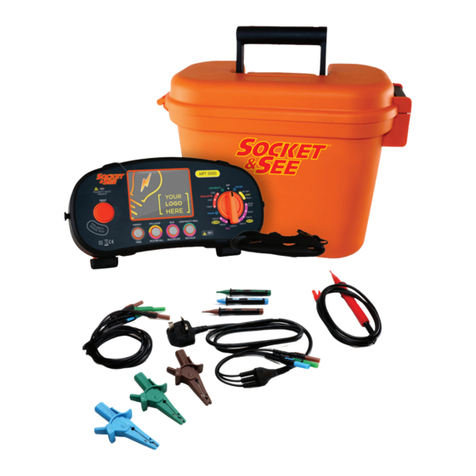
Socket & See
Socket & See MFT5000 User manual
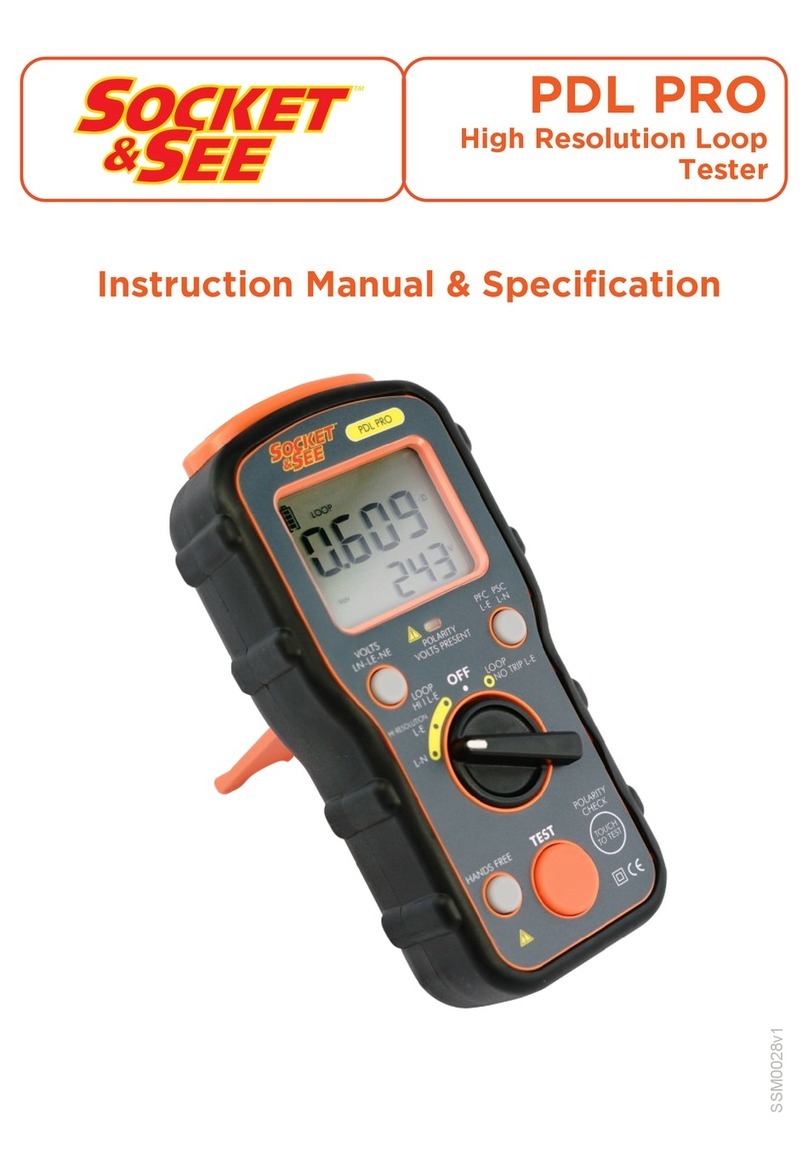
Socket & See
Socket & See PDL PRO User manual
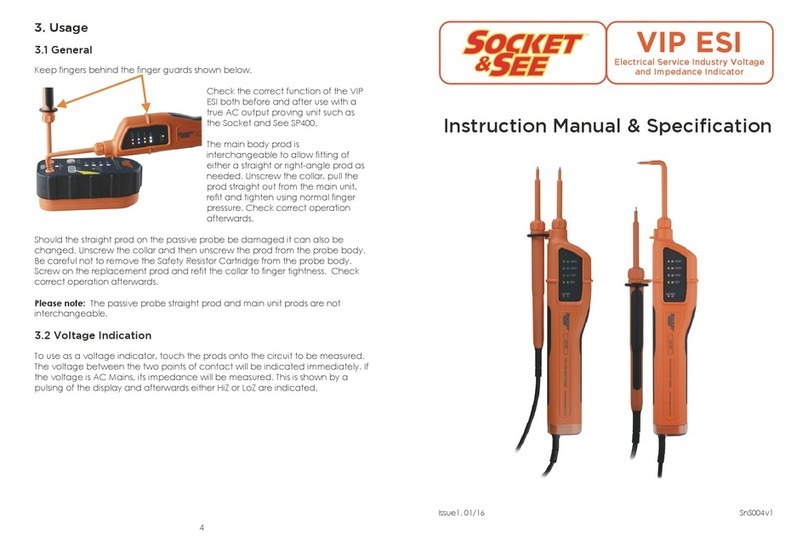
Socket & See
Socket & See VIP ESI User manual

Socket & See
Socket & See PDRC 380 User manual
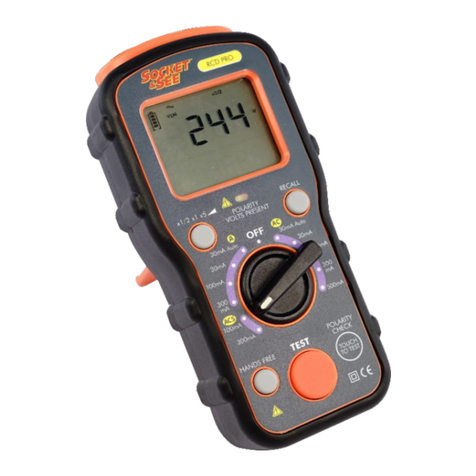
Socket & See
Socket & See RCD PRO User manual
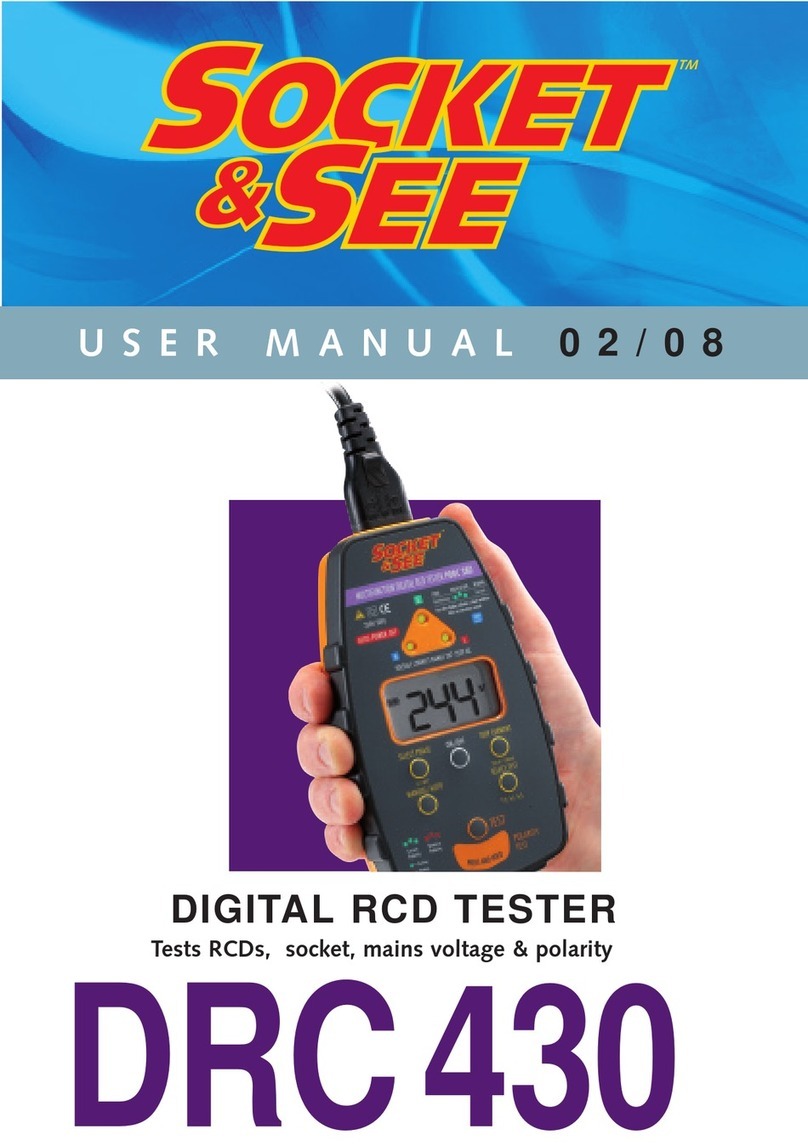
Socket & See
Socket & See DRC430 User manual
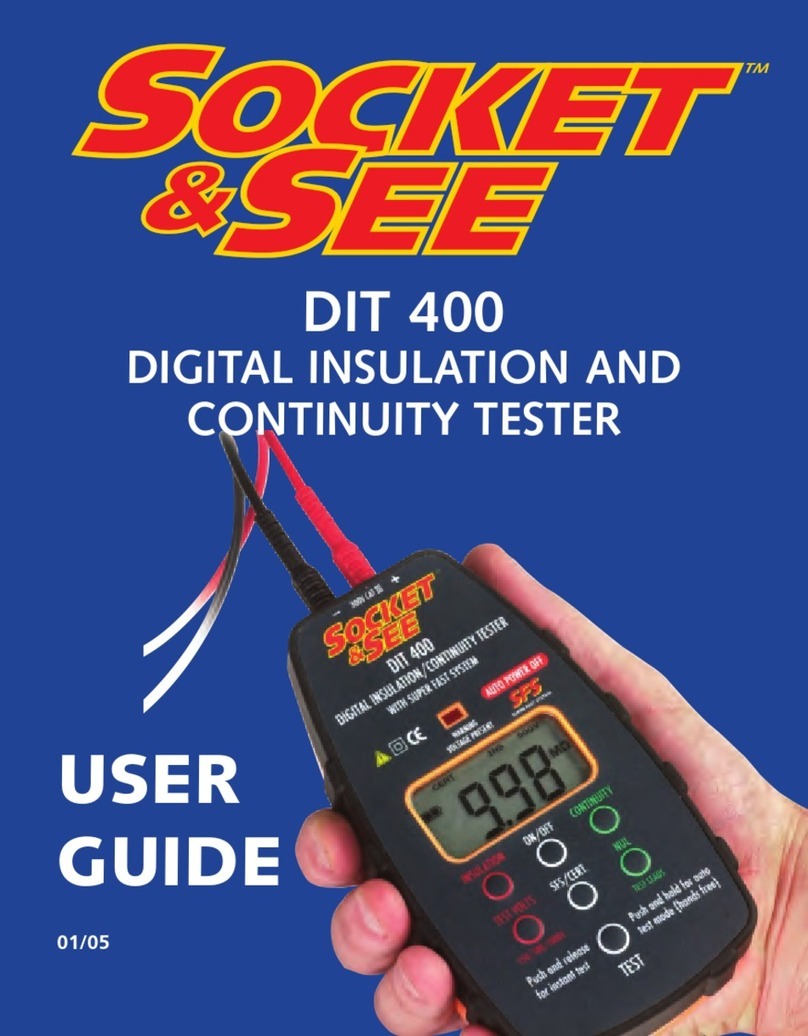
Socket & See
Socket & See DIT 400 User manual
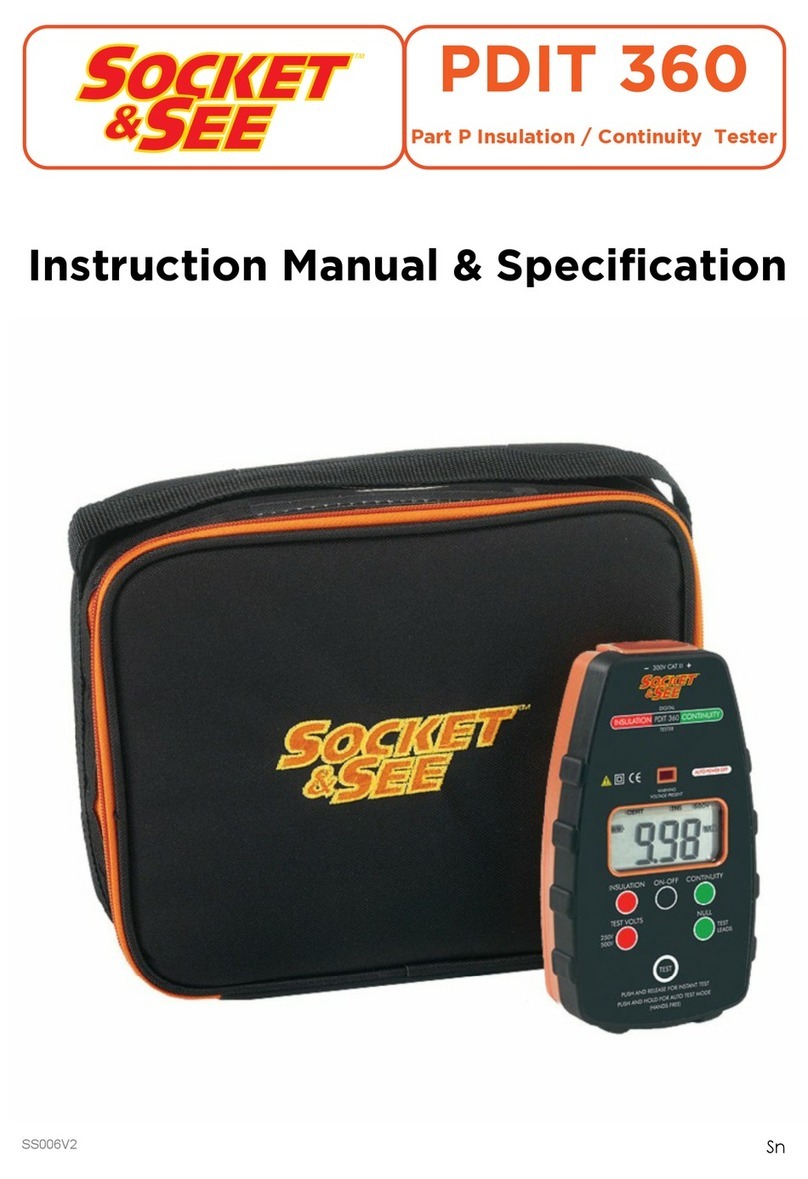
Socket & See
Socket & See PDIT 360 User manual
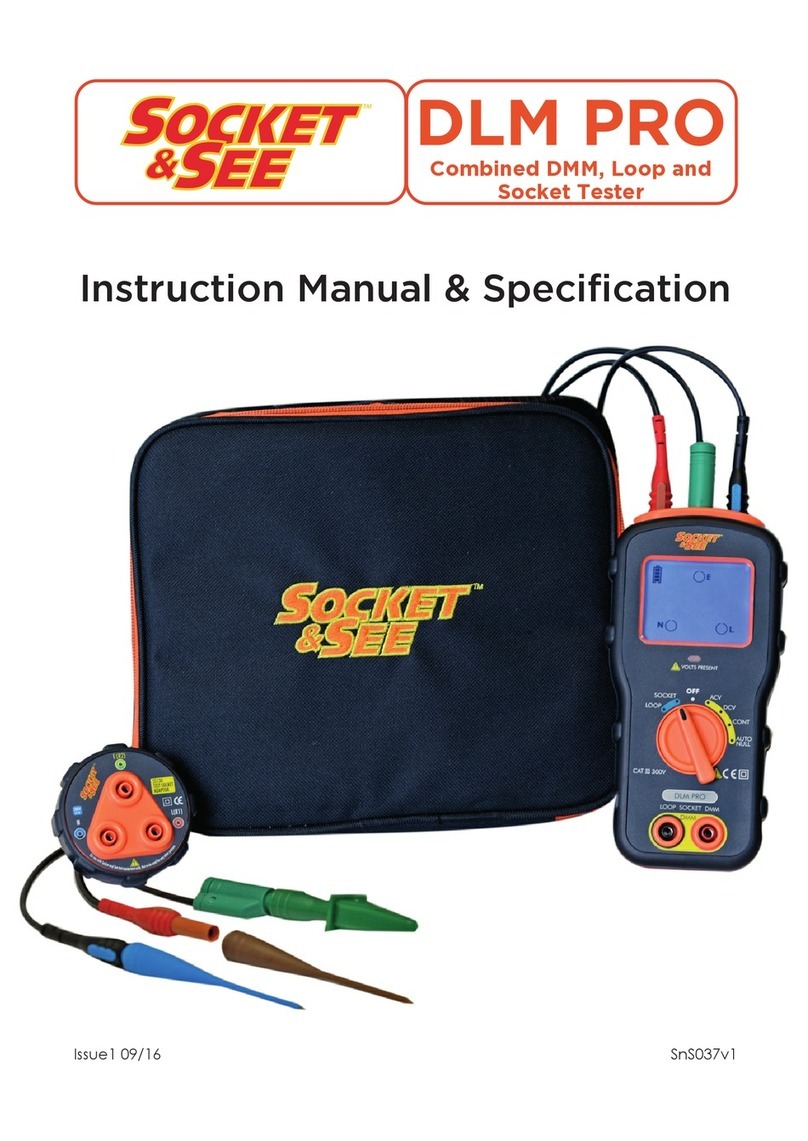
Socket & See
Socket & See DLM PRO User manual

Socket & See
Socket & See FFCB 100 User manual
